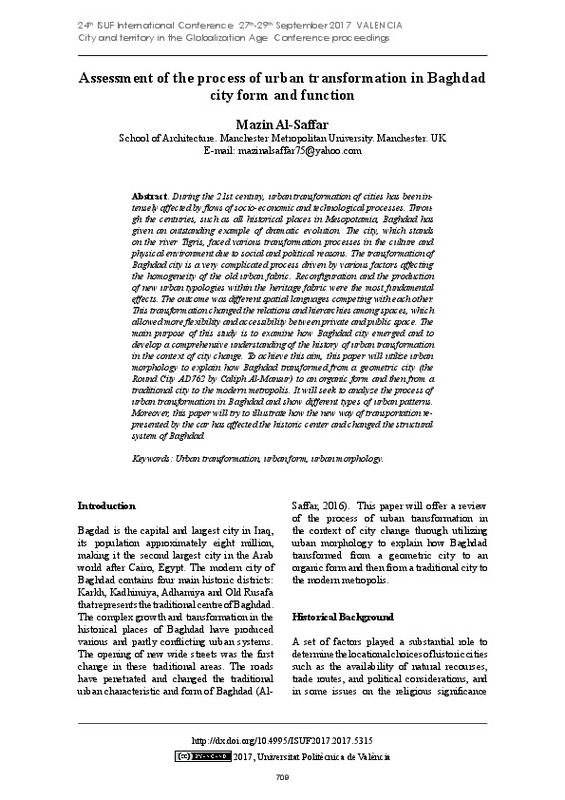JavaScript is disabled for your browser. Some features of this site may not work without it.
Buscar en RiuNet
Listar
Mi cuenta
Estadísticas
Ayuda RiuNet
Admin. UPV
Assessment of the process of urban transformation in Baghdad city form and function
Mostrar el registro sencillo del ítem
Ficheros en el ítem
| dc.contributor.author | Al-Saffar, Mazin
|
es_ES |
| dc.coverage.spatial | east=44.36606710000001; north=33.315241; name= Baghdad, Iraq | es_ES |
| dc.date.accessioned | 2018-12-20T13:27:17Z | |
| dc.date.available | 2018-12-20T13:27:17Z | |
| dc.date.issued | 2018-04-20 | |
| dc.identifier.isbn | 9788490485743 | |
| dc.identifier.uri | http://hdl.handle.net/10251/114292 | |
| dc.description.abstract | [EN] During the 21st century, urban transformation of cities has been intensely affected by flows of socio-economic and technological processes. Through the centuries, such as all historical places in Mesopotamia, Baghdad has given an outstanding example of dramatic evolution. The city, which stands on the river Tigris, faced various transformation processes in the culture and physical environment due to social and political reasons. The transformation of Baghdad city is a very complicated process driven by various factors affecting the homogeneity of the old urban fabric. Reconfiguration and the production of new urban typologies within the heritage fabric were the most fundamental effects. The outcome was different spatial languages competing with each other. This transformation changed the relations and hierarchies among spaces, which allowed more flexibility and accessibility between private and public space. The main purpose of this study is to examine how Baghdad city emerged and to develop a comprehensive understanding of the history of urban transformation in the context of city change. To achieve this aim, this paper will utilise urban morphology to explain how Baghdad transformed from a geometric city (the Round City AD762 by Caliph Al-Mansur) to an organic form and then from a traditional city to the modern metropolis. It will seek to analyse the process of urban transformation in Baghdad and show different types of urban patterns. Moreover, this paper will try to illustrate how the new way of transportation represented by the car has affected the historic centre and changed the structural system of Baghdad. | es_ES |
| dc.format.extent | 10 | es_ES |
| dc.language | Inglés | es_ES |
| dc.publisher | Editorial Universitat Politècnica de València | es_ES |
| dc.relation.ispartof | 24th ISUF International Conference. Book of Papers | es_ES |
| dc.rights | Reconocimiento - No comercial - Sin obra derivada (by-nc-nd) | es_ES |
| dc.subject | Urban transformation | es_ES |
| dc.subject | Urban form | es_ES |
| dc.subject | Urban morphology | es_ES |
| dc.title | Assessment of the process of urban transformation in Baghdad city form and function | es_ES |
| dc.type | Capítulo de libro | es_ES |
| dc.type | Comunicación en congreso | es_ES |
| dc.identifier.doi | 10.4995/ISUF2017.2017.5315 | |
| dc.rights.accessRights | Abierto | es_ES |
| dc.description.bibliographicCitation | Al-Saffar, M. (2018). Assessment of the process of urban transformation in Baghdad city form and function. En 24th ISUF International Conference. Book of Papers. Editorial Universitat Politècnica de València. 709-718. https://doi.org/10.4995/ISUF2017.2017.5315 | es_ES |
| dc.description.accrualMethod | OCS | es_ES |
| dc.relation.conferencename | 24th ISUF 2017 - City and Territory in the Globalization Age | es_ES |
| dc.relation.conferencedate | Septiembre 27-29,2017 | es_ES |
| dc.relation.conferenceplace | Valencia, Spain | es_ES |
| dc.relation.publisherversion | http://ocs.editorial.upv.es/index.php/ISUF/ISUF2017/paper/view/5315 | es_ES |
| dc.description.upvformatpinicio | 709 | es_ES |
| dc.description.upvformatpfin | 718 | es_ES |
| dc.type.version | info:eu-repo/semantics/publishedVersion | es_ES |
| dc.relation.pasarela | OCS\5315 | es_ES |








